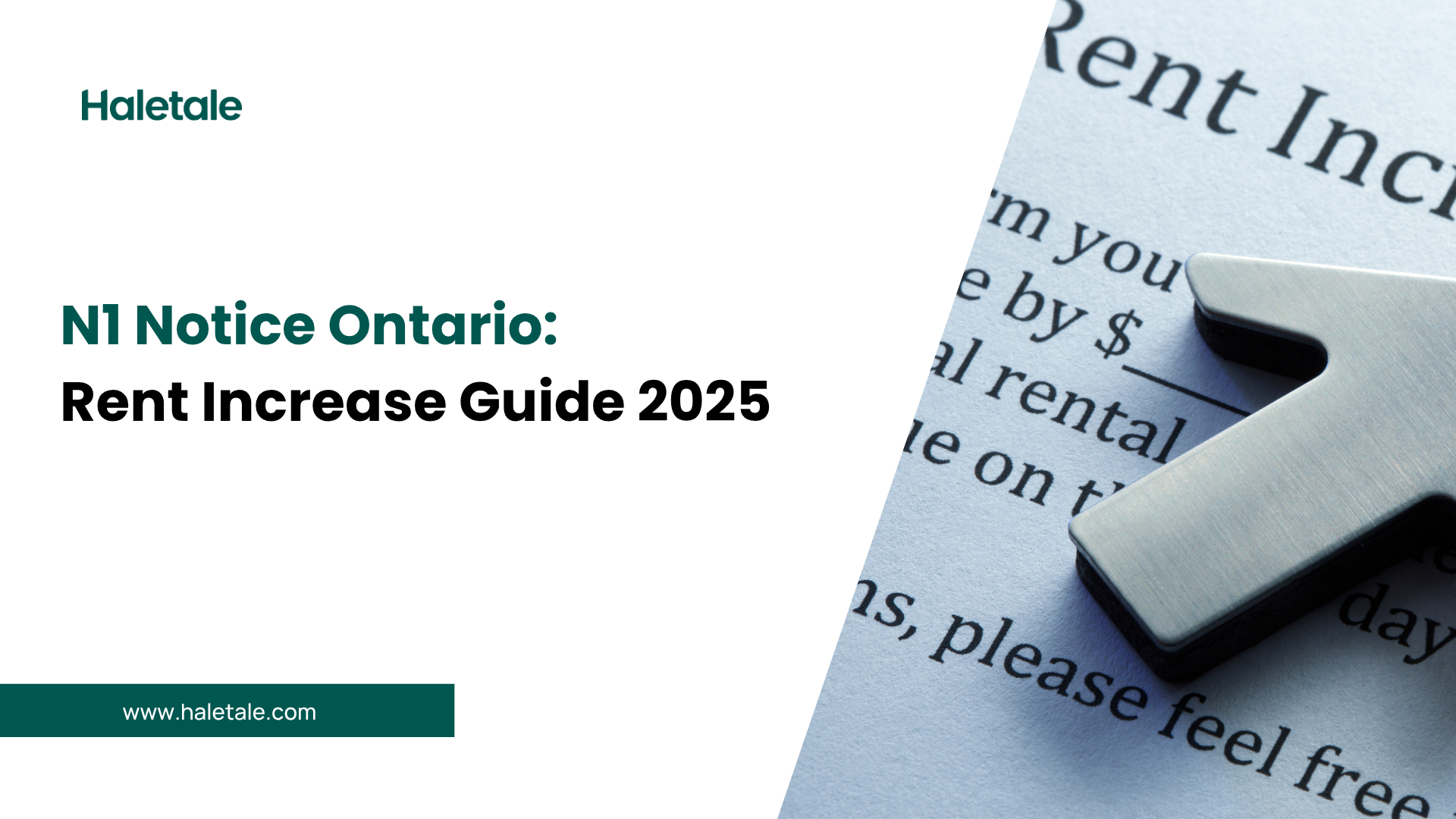How to Properly Increase Rent in Ontario 2025: The Complete N1 Notice Guide for Landlords
The N1 notice for rent increase affects over 1.7 million rental units across Ontario, yet 31% of landlords and property managers make costly errors that delay or invalidate their increases, losing an average of $3,600 annually per unit. For property managers handling multiple properties, mastering the N1 Notice of Rent Increase isn’t just about compliance—it’s about protecting your investment’s profitability while maintaining positive tenant relationships in an increasingly complex regulatory environment.
2025 Update: Critical Changes
The Ontario government has set the 2025 rent increase guideline at 2.5%, with new digital service provisions and updated calculation methods for utilities. This guide reflects all current requirements and recent LTB clarifications.
Quick N1 Reference Guide
| N1 Essential Facts | Details |
| 2025 Guideline | 2.5% maximum |
| Notice Period | 90 days minimum |
| Frequency | Once per 12 months |
| First Increase | 12 months after tenancy starts |
| Form Version | Must use current 2025 form |
| Service Methods | Physical delivery required |
| Can Tenant Refuse? | No, if properly served |
Understanding the N1 Notice
What Makes N1 Ontario’s Most Used Notice
The N1 Notice of Rent Increase represents the foundation of sustainable property management in Ontario. Unlike other provinces where market rates prevail, Ontario’s rent control system requires precise adherence to guidelines and procedures through the N1 form.
Every year, over 400,000 N1 notices are served across the province, generating approximately $480 million in additional rental income for property owners. Yet recent data shows that improper N1 service costs landlords millions in lost revenue opportunities.
The Legal Framework Behind N1
The Residential Tenancies Act governs rent increases through a carefully balanced system:
- Protection for tenants from excessive increases
- Predictability for landlords in revenue planning
- Standardization across all controlled units
- Exceptions for newer buildings and special circumstances
For modern property management companies, understanding these nuances determines whether rent increases proceed smoothly or face challenges that can delay revenue for months.
Why Precision Matters More Than Ever
The Cost of N1 Errors:
- Invalid notice: Must wait another 90 days
- Calculation mistakes: Potential LTB orders to repay
- Timeline errors: Full year delay possible
- Wrong form version: Complete invalidity
Professional property management software eliminates these risks through automated compliance checking and calculation verification.
2025 Rent Increase Guidelines
Understanding the 2.5% Limit
The 2025 guideline of 2.5% represents the maximum allowable increase for most residential units without additional approval. This rate, set annually by the Ontario government, reflects economic factors including inflation and operating cost changes.
Calculating Your Increase
For Monthly Rent of $2,000:
- Maximum increase: $50 (2.5%)
- New rent: $2,050
- Annual impact: $600
For Monthly Rent of $1,500:
- Maximum increase: $37.50 (2.5%)
- New rent: $1,537.50
- Annual impact: $450
Automated rent calculators ensure accurate calculations across entire portfolios.
Historical Context and Trends
| Year | Guideline | Economic Context |
| 2025 | 2.5% | Moderate inflation period |
| 2024 | 2.5% | Stabilization post-pandemic |
| 2023 | 2.5% | Recovery phase |
| 2022 | 1.2% | Pandemic support |
| 2021 | 0% | Rent freeze |
Understanding these trends helps property managers plan long-term revenue strategies.
Above Guideline Increases (AGI)
While N1 limits increases to 2.5%, landlords can apply for above-guideline increases through separate LTB applications for:
- Extraordinary operating cost increases
- Capital expenditures (major repairs/upgrades)
- Security services additions
AGI applications require extensive documentation and face scrutiny, making the standard N1 increase more predictable for most properties.
Eligibility Requirements
The Four Pillars of N1 Eligibility
1. Twelve-Month Rule
You cannot increase rent until:
- 12 months have passed since tenancy began, OR
- 12 months since the last rent increase
Common Confusion Points:
- Date counts from when tenancy started, not lease signing
- Previous landlord’s increases count toward 12-month calculation
- Rent reductions don’t reset the clock
Tenant tracking systems automatically monitor eligibility dates across portfolios.
2. Unit Must Be Covered Under Rent Control
Rent-Controlled Units Include:
- Buildings first occupied before November 15, 2018
- Social housing units
- Nursing homes
- Mobile home parks
Exempt Units (Use N2 Instead):
- First occupied after November 15, 2018
- Additions to existing buildings after November 15, 2018
- Some converted commercial spaces
3. Proper Tenancy Status
Eligible Tenancies:
- Active month-to-month
- Fixed-term leases
- Renewed tenancies
- Continued occupancies
Ineligible Situations:
- Vacant units
- Between tenancies
- Under eviction proceedings
- Unauthorized occupants
4. Compliance with Previous Obligations
Before serving N1, ensure:
- All maintenance obligations met
- No outstanding LTB orders against you
- Previous rent receipts provided
- Required documents delivered
Compliance tracking features help maintain eligibility across multiple properties.
The 90-Day Timeline
Precision in Timing Calculations
The 90-day notice requirement is absolute and unforgiving. Even being one day short invalidates the entire notice.
Breaking Down the Timeline
Day 0: Service Date
- The day you serve the N1
- Must be documented precisely
- Not included in 90-day count
Days 1-30: Early Period
- Tenant processes increase
- Questions typically arise
- Payment method updates needed
Days 31-60: Preparation Phase
- Tenant budget adjustments
- Pre-authorized payment updates
- Communication about changes
Days 61-89: Final Preparation
- Reminder communications
- System updates
- Final clarifications
Day 90: Earliest Effective Date
- Must align with rental period
- Cannot be mid-month for monthly tenancies
- First increased payment due
Calculating Effective Dates
For Monthly Tenancies: If serving N1 on March 1, 2025:
- 90 days = May 30, 2025
- Effective date: June 1, 2025 (next rental period)
If serving N1 on March 15, 2025:
- 90 days = June 13, 2025
- Effective date: July 1, 2025 (must be full rental period)
Automated timeline calculators prevent costly date calculation errors.
Service Method Impact on Timelines
| Service Method | Additional Days | Total Notice Period |
| Hand delivery | 0 | 90 days |
| Under door/mailbox | 0 | 90 days |
| +5 days | 95 days | |
| Posted on door | 0 | 90 days |
Step-by-Step N1 Process
Phase 1: Pre-Service Preparation
Step 1: Verify Eligibility
✅ Checklist:
- [ ] 12 months since last increase/tenancy start
- [ ] Unit is rent-controlled
- [ ] Current tenant in good standing
- [ ] No outstanding maintenance issues
- [ ] Correct guideline percentage confirmed
Step 2: Calculate New Rent
Calculation Formula:
Current Rent × 1.025 = New Rent (2025 guideline)
$1,850 × 1.025 = $1,896.25 (rounds to $1,896)
Rounding Rules:
- Round down to nearest dollar
- Never round up
- Document calculation method
Financial integration tools ensure accurate calculations across all units.
Step 3: Prepare the N1 Form
Section 1: Tenant Information
- Full legal names (all tenants)
- Complete unit address
- Current contact information
Section 2: Rent Details
- Current rent amount
- New rent amount
- Percentage increase (must not exceed 2.5%)
- Effective date
Section 3: Utility Inclusions
- List all included utilities
- Note any changes
- Separate utility adjustments if applicable
Phase 2: Service and Documentation
Step 4: Choose Service Method
Best Practice Hierarchy:
- Personal handover – Most defensible
- Under door – Acceptable if tenant absent
- Mailbox – If secure and accessible
- Posted on door – Last resort
- Mail – Only if other methods impossible
Step 5: Complete Service
Service Day Checklist:
- [ ] Correct N1 form version
- [ ] All pages included
- [ ] Information sheet attached
- [ ] Keep copy for records
- [ ] Complete Certificate of Service
- [ ] Photo of service (if applicable)
Digital documentation systems create tamper-proof service records.
Step 6: File Certificate of Service
Required Information:
- Date and time of service
- Method used
- Person who served
- Any tenant response
- Signature of server
Phase 3: Post-Service Management
Step 7: Update Systems
Administrative Updates:
- Property management software
- Accounting systems
- Payment processors
- Tenant portal
- Lease records
Step 8: Tenant Communication
30 Days Before Increase:
- Send friendly reminder
- Confirm payment method changes
- Answer any questions
- Update pre-authorized debits
Week Before Increase:
- Final reminder
- Confirm new amount
- Payment date reminder
Step 9: Implementation
First Increased Rent Date:
- Monitor payment receipt
- Verify correct amount
- Document successful increase
- Update financial projections
Common N1 Mistakes That Cost Thousands
The Top 10 N1 Errors
1. Using Outdated Forms
The Problem: LTB updates forms regularly The Cost: Complete invalidity, 90+ day delay The Solution: Automated form updates
2. Incorrect Timeline Calculation
The Problem: Counting days wrong The Cost: Invalid notice, restart required The Solution: Digital timeline calculators
3. Exceeding Guideline Rate
The Problem: Calculating more than 2.5% The Cost: Tenant challenge, rollback ordered The Solution: Automated calculation verification
4. Wrong Effective Date
The Problem: Mid-period increases The Cost: Confusion, payment issues The Solution: Rental period alignment tools
5. Missing Tenant Names
The Problem: Not listing all tenants The Cost: Invalid service claims The Solution: Comprehensive tenant tracking
6. Calculation Errors
The Problem: Math mistakes The Cost: Overcharge liability The Solution: Automated calculations
7. Improper Service
The Problem: Email or text delivery The Cost: Unenforceable increase The Solution: Approved method guidance
8. Too-Early Service
The Problem: Serving before 12 months The Cost: Complete invalidity The Solution: Eligibility tracking systems
9. No Documentation
The Problem: Missing service proof The Cost: Cannot defend if challenged The Solution: Digital documentation
10. Ignoring Exemptions
The Problem: Using N1 for exempt units The Cost: Wrong form, wrong process The Solution: Unit classification tracking
Special Situations and Exemptions
Newer Buildings (Post-November 2018)
Buildings first occupied after November 15, 2018, are exempt from rent control:
- Use N2 form instead of N1
- No percentage limit applies
- Still requires 90-day notice
- Market rates permissible
Portfolio management systems track which units require N1 versus N2.
Care Homes and Retirement Facilities
Special rules apply for:
- Care services included
- Meal programs
- Medical services
- Support services
Use N3 form for these components while N1 covers base rent only.
Subsidized Housing
RGI (Rent-Geared-to-Income) Units:
- Different calculation methods
- Income verification required
- Special notice requirements
- Coordination with housing providers
Utility Inclusion Changes
When utilities shift from landlord to tenant:
- Requires separate notice
- May affect rent amount
- Cannot exceed guideline when combined
- Documentation essential
Utility tracking features help manage complex inclusion changes.
Digital Automation for N1 Notices
Transform Your Rent Increase Process
Modern property management demands digital solutions for N1 compliance. Manual processes risk errors that cost thousands in lost revenue.
Automated Eligibility Tracking
System Monitors:
- Last increase dates
- 12-month milestones
- Tenant status
- Unit classifications
- Guideline updates
Smart Alerts:
“Unit 205 eligible for rent increase in 30 days”
“Prepare N1 notices for Building A – 15 units eligible”
“2025 guideline released – update calculations”
Cloud-based platforms ensure you never miss an increase opportunity.
Calculation Automation
Automatic Computations:
- Current rent pulled from system
- Guideline percentage applied
- Rounding rules enforced
- New rent calculated
- Effective date determined
Batch Processing
For portfolios with multiple units:
- Generate dozens of N1s simultaneously
- Maintain individual customization
- Ensure consistency
- Track service dates
- Monitor outcomes
Integration Benefits
Connected Systems:
- Accounting software for financial updates
- Payment processors for new amounts
- Tenant portals for communication
- Banking for pre-authorized debits
- Reporting for revenue projections
N1 FAQs
Timing and Calculation Questions
Q: Can I increase rent by less than 2.5%? A: Yes, you can increase by any amount up to 2.5%. Some landlords choose smaller increases to maintain tenant satisfaction.
Q: What if my tenant’s lease renews mid-year? A: Lease renewal doesn’t affect rent increase eligibility. The 12-month rule applies regardless of lease terms.
Q: Can I serve N1 during a fixed-term lease? A: Yes, as long as the increase takes effect after 12 months of tenancy, even within a fixed term.
Service and Compliance Questions
Q: Is email service valid if my tenant agrees? A: No, even with agreement, email isn’t recognized for N1 service. Physical delivery is required.
Q: What if I made an error on the N1? A: You must serve a new, correct N1 with a fresh 90-day notice period. The original is void.
Q: Can tenants refuse the increase? A: No, properly served N1 increases are mandatory. Tenants can only move out if they object.
Special Situation Questions
Q: How do I handle partial month tenancies? A: Prorate the increase for partial periods using daily calculations based on the number of days in that month.
Q: What about tenants who pay quarterly? A: The same rules apply, but ensure 90 days notice before the next quarterly payment date.
Q: Can I increase parking separately? A: If parking is a separate agreement, it may not be subject to rent control. If included in rent, it’s part of the controlled amount.
Legal compliance tools help navigate complex situations correctly.
Take Action Today
Don’t Leave Money on the Table
Every month you delay proper rent increases costs your portfolio:
- Lost revenue: $37.50-$125/unit monthly
- Compound effect: Can’t make up missed increases
- Portfolio impact: Thousands in annual losses
- Market positioning: Fall behind comparable properties
Automate Your Rent Increases with Haletale
See how successful property managers never miss an increase opportunity:
Platform Features:
- Automatic eligibility tracking
- Bulk N1 generation
- Timeline monitoring
- Service documentation
- Revenue impact reporting
Start Your Free Trial
Join hundreds of Ontario property managers maximizing returns with automated compliance:
Conclusion: Master N1 for Sustainable Growth
The N1 notice represents more than just a rent increase—it’s your tool for maintaining profitable, sustainable property management in Ontario’s regulated environment. While the 2.5% guideline may seem modest, consistent, proper increases compound into significant portfolio value over time.
Success with N1 notices requires precision in timing, accuracy in calculations, and meticulous documentation. One mistake can cost months of delays and thousands in lost revenue. That’s why leading property management companies have embraced digital automation for N1 compliance.
By mastering the N1 process—from eligibility verification through successful implementation—you ensure your properties remain competitive while maintaining positive tenant relationships. The key is consistency, compliance, and leveraging technology to eliminate human error.
Don’t let another year pass without maximizing your legal rent increases. Every delayed or missed N1 is money left on the table that you’ll never recover.
Last Updated: September 17, 2025 | All information current as of publication date. Always verify current requirements with the LTB.









